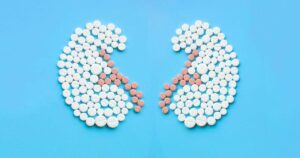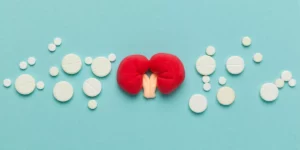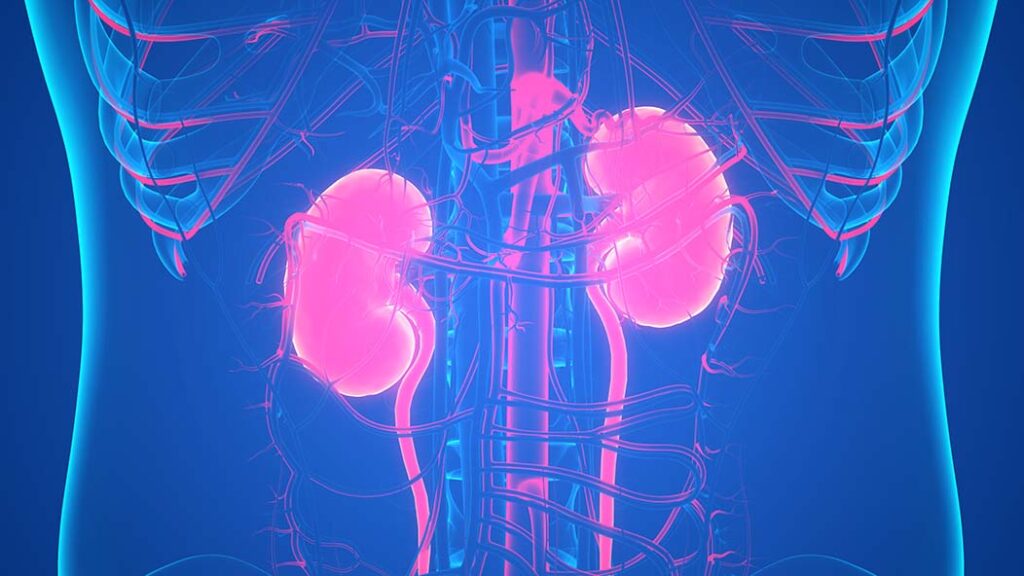The kidneys, vital organs responsible for filtering waste from the blood, can be severely damaged by the high blood sugar levels characteristic of diabetes. This damage can lead to chronic kidney disease (CKD) or even end-stage renal disease (ESRD), necessitating dialysis or a kidney transplant. So, this blog delves into the world of renal-protective diabetes medications, a breakthrough in diabetes care that offers hope for preserving kidney health in diabetic patients. We will explore how these medications work, their benefits, and their role in a comprehensive diabetes management plan.
Contents
What Are Renal Protective Drugs?
 Renal protective drugs are a class of medications specifically designed to safeguard kidney function, especially in individuals with conditions that predispose them to kidney damage, such as diabetes and hypertension. These drugs work by addressing various pathways that lead to kidney damage. For instance, in the context of diabetes, they help in controlling blood sugar levels and also directly protect the kidneys by reducing the stress on the filtering units (glomeruli) and decreasing proteinuria. It is a common marker of kidney damage.
Renal protective drugs are a class of medications specifically designed to safeguard kidney function, especially in individuals with conditions that predispose them to kidney damage, such as diabetes and hypertension. These drugs work by addressing various pathways that lead to kidney damage. For instance, in the context of diabetes, they help in controlling blood sugar levels and also directly protect the kidneys by reducing the stress on the filtering units (glomeruli) and decreasing proteinuria. It is a common marker of kidney damage.
Medications are becoming increasingly important in the management of chronic kidney disease, particularly in diabetic patients. Because they can delay the need for more intensive treatments like dialysis or kidney transplantation. Their growing use underscores a shift in focus from merely managing symptoms to actively protecting organ function in chronic disease management.
What Are Some Renal Protective Diabetes Medications?
Renal protective diabetes medications are specifically designed to safeguard the kidneys from damage often caused by long-term complications of diabetes. Some of the key groups of these medications include:
SGLT2 Inhibitors (Sodium-Glucose Cotransporter-2 Inhibitors)
This class of drugs works by preventing the kidneys from reabsorbing glucose back into the blood. This not only helps to lower blood glucose levels but also reduces the workload on the kidneys. Examples include:
- Empagliflozin (Jardiance)
- Canagliflozin (Invokana)
- Dapagliflozin (Farxiga)
GLP-1 Receptor Agonists (Glucagon-Like Peptide-1 Receptor Agonists)
Although primarily used for blood sugar control, some drugs in this class have shown benefits in protecting kidney function. They work by enhancing insulin secretion and suppressing glucagon release. Examples include:
- Liraglutide (Victoza)
- Semaglutide (Ozempic)
- Dulaglutide (Trulicity)
ACE Inhibitors (Angiotensin-Converting Enzyme Inhibitors)
Traditionally used for treating high blood pressure and heart conditions, ACE inhibitors can also protect the kidneys by reducing blood pressure and decreasing proteinuria (protein in the urine). Examples include:
- Lisinopril (Zestril)
- Enalapril (Vasotec)
- Ramipril (Altace)
ARBs (Angiotensin II Receptor Blockers)
Similar to ACE inhibitors, ARBs lower blood pressure and reduce strain on the kidneys. They are often used when ACE inhibitors are not tolerated. Examples include:
- Losartan (Cozaar)
- Valsartan (Diovan)
- Irbesartan (Avapro)
DPP-4 Inhibitors (Dipeptidyl Peptidase-4 Inhibitors)
While their primary role is to manage blood glucose levels, some evidence suggests they may offer mild kidney protection. They work by increasing insulin release and decreasing glucagon levels. Examples include:
- Sitagliptin (Januvia)
- Saxagliptin (Onglyza)
- Linagliptin (Tradjenta)
It’s important to note that while these medications can offer renal protection, their suitability for any individual patient depends on various factors including the stage of kidney disease, overall health, and other medical conditions. Healthcare providers typically make medication decisions based on comprehensive patient assessments.
What Are The Benefits To Expect?
 The benefits of using renal protective diabetes medications are multifaceted, addressing both diabetes management and kidney health. Patients can expect several key advantages:
The benefits of using renal protective diabetes medications are multifaceted, addressing both diabetes management and kidney health. Patients can expect several key advantages:
- Improved Blood Sugar Control: Many of these medications, especially SGLT2 inhibitors, GLP-1 receptor agonists, and DPP-4 inhibitors, are effective in lowering blood glucose levels. This helps in the overall management of diabetes, reducing the risk of complications associated with high blood sugar.
- Reduction in Kidney Damage: These drugs play a crucial role in protecting the kidneys from the harmful effects of high blood sugar and hypertension. They can reduce the progression of kidney disease by lowering blood pressure, decreasing proteinuria (protein in the urine, a sign of kidney damage), and mitigating stress on the kidneys.
- Cardiovascular Benefits: Many renal-protective diabetes medications have been shown to reduce the risk of cardiovascular events like heart attacks and strokes. This is particularly important as diabetes significantly increases the risk of heart disease.
- Delay in Progression to End-Stage Kidney Disease: By protecting the kidneys, these medications can slow the progression of kidney disease, potentially delaying the need for more aggressive treatments like dialysis or kidney transplantation.
- Reduced Risk of Hypoglycemia: Certain drugs, such as SGLT2 inhibitors and GLP-1 receptor agonists, have a lower risk of causing hypoglycemia (low blood sugar) compared to older diabetes medications, making them a safer option for some patients.
- Weight Loss and Blood Pressure Control: Some of these medications, particularly SGLT2 inhibitors and GLP-1 receptor agonists, can aid in weight loss and better blood pressure control, which are beneficial in managing both diabetes and kidney health.
Patients need to understand that while these medications offer significant benefits, they must be part of a comprehensive diabetes management plan. And that includes a healthy diet, regular physical activity, and regular monitoring of blood sugar and kidney function.
Risks And Considerations Of Renal Protective Diabetes Medications
 While renal protective diabetes medications offer significant benefits, it’s important to consider potential risks and special considerations associated with their use:
While renal protective diabetes medications offer significant benefits, it’s important to consider potential risks and special considerations associated with their use:
Risk of Hypotension
Medications like ACE inhibitors and ARBs can lower blood pressure, which is generally beneficial. However, in some cases, they can lead to hypotension (abnormally low blood pressure), especially if taken in combination with other blood pressure-lowering drugs or in patients with dehydration.
Hyperkalemia
ACE inhibitors and ARBs can increase potassium levels in the blood, leading to hyperkalemia, a condition that can be dangerous if not monitored and managed properly.
Risk of Acute Kidney Injury (AKI)
In certain situations, such as in cases of severe dehydration or acute illness, medications like SGLT2 inhibitors may increase the risk of AKI. Patients need to be educated about the signs of dehydration and the importance of maintaining adequate fluid intake.
Genital and Urinary Tract Infections
SGLT2 inhibitors can increase the risk of genital and urinary tract infections due to the mechanism of glucose excretion through the urine. Good personal hygiene and regular medical check-ups are important for early detection and treatment of these infections.
Gastrointestinal Side Effects
GLP-1 receptor agonists can cause gastrointestinal side effects like nausea, vomiting, and diarrhea. Although these are usually mild and tend to improve over time, they can be bothersome for some patients.
Potential for Drug Interactions
As with any medication, there is a potential for interactions with other drugs. It is important for patients to inform healthcare providers about all medications they are taking, including over-the-counter drugs and supplements.
Pregnancy and Lactation
Some of these medications may not be safe during pregnancy or breastfeeding. Women of childbearing age should discuss family planning and potential risks with their healthcare provider.
Cost and Accessibility
The cost and availability of these medications can be a barrier for some patients. It’s important to consider economic factors and explore options like generic drugs or patient assistance programs.
Given these considerations, it’s crucial for patients to have regular follow-ups with their healthcare provider to monitor their condition and adjust treatment as needed. Personalized treatment plans, considering individual risks and benefits, are key to effectively managing diabetes while protecting kidney health.
Conclusion
In conclusion, renal protective diabetes medications represent a significant advancement in managing diabetes with an added focus on preserving kidney health. These drugs, including SGLT2 inhibitors, GLP-1 receptor agonists, ACE inhibitors, and ARBs, offer a dual benefit of controlling blood sugar levels and protecting the kidneys from damage, a common complication in diabetes. While they come with a range of benefits, it’s important to be aware of their risks and specific considerations.
Ultimately, these medications should be part of a broader diabetes management plan, tailored to individual needs and monitored by healthcare professionals. Do you want to get rid of diabetes? Join our online diabetes treatment program and reverse Diabetes naturally through lifestyle changes such as a Personalized Diet plan, Exercise, Yoga, dieticians, and health coaches.

